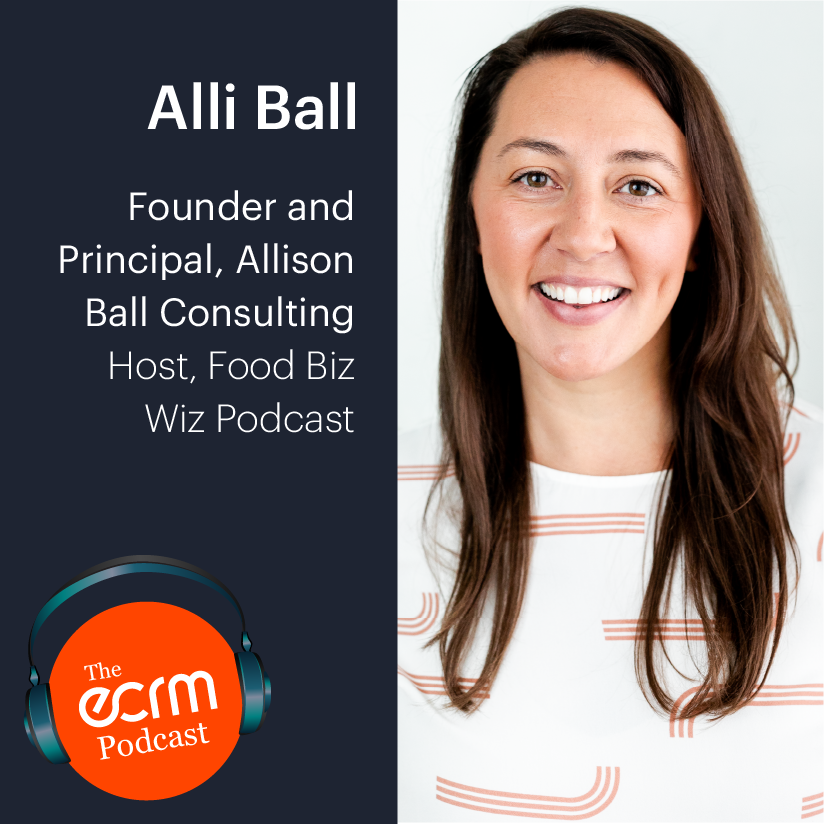Creating a Path to Brand Success: Goal-Setting Strategies for 2021 1/6/2021
 For most people, the start of the new year involves setting goals, and so for our first podcast of 2021 our focus is exactly that. For this episode, I spoke once again with Alli Ball, a former grocery buyer and founder of Allison Ball Consulting and host of the Food Biz Wiz podcast, who works with emerging food and beverage brands to help them succeed at retail.
For most people, the start of the new year involves setting goals, and so for our first podcast of 2021 our focus is exactly that. For this episode, I spoke once again with Alli Ball, a former grocery buyer and founder of Allison Ball Consulting and host of the Food Biz Wiz podcast, who works with emerging food and beverage brands to help them succeed at retail.
Alli takes us through the steps and strategies brand-owners can take to set and achieve effective goals (and common mistakes to avoid in doing so). She then shows us how to reverse-engineer those goals into tactics and timelines that will deliver optimal success without becoming overwhelming.
And, while it's not in the overview, in the full podcast and videos below, Alli and I also go off on a fun sidbar conversation about productivity hacks that we each employ, and how these can be applied to your goal-setting practices, so you definitely want to check those out!
Why set goals?
While it may seem a rudimentary question, the reason why it’s important to set goals is to give you a good idea of how to focus your efforts. As entrepreneurs, brand-owners are their own bosses, and make all of their own decisions. While this has its benefits, it can also pose challenges as there are just so many directions that they can take.
LISTEN TO THE PODCAST
Goals also provide a benchmark for measuring success. “If we don’t set goals, we can’t measure our success and identify areas in which we can improve,” says Ball. “And while this might sound counterintuitive, I don’t care if you hit those goals or not. It’s more about the systems and processes that we put into place along the way toward reaching those goals. That’s what drives the business forward long-term.”
Common mistakes in setting goals
Before we dive into the strategies, let’s address come common mistakes people make when trying to set goals. One common mistake has to do with timing. “People focus on the wrong goals at the wrong time in their business,” says Ball. “For example, one goal might be to get their products into Whole Foods Market in 2021. But if you don’t have your marketing strategy dialed in, your branding perfected, and your plan for product discovery in place, it’s not worth it to land on that shelf yet. The end goal is not appropriate at this stage of the business.”
One unique method Ball uses to determine if the timing is correct is to ask yourself, “if I achieve this goal, will it break my business?” Using the Whole Foods example above, if the brand succeeded in getting into Whole Foods, and the products sell well, will they be able to accommodate that success? Will they be able to ramp up their production, distribution and marketing capabilities to handle the volume? If not, then the timing of the goal is off, and perhaps they should focus on one that’s more realistically attainable.
Another mistake in goal-setting is not understanding the difference between a goal and a tactic. The goal is the large, aspirational and quantifiable outcome you are looking to achieve. The tactics are all of those steps and moving parts it takes to get to that outcome.
“So your goal may be to increase your wholesale accounts by 30 percent for the year,” says Ball. “The tactics to get to that goal would include participating in ECRM's category-specific programs and Supplier Introductions, creating a great sales sheet, developing a solid virtual sales pitch, understanding placement deals, and hiring brand ambassadors.”
In addition, each of these tactics may have sub-tactics. If you are participating in an ECRM program, for example, you need to build your RangeMe profile, prepare your presentation and make sure you have all of your virtual meeting tech optimized. You’ll also need to research the buyers you will be meeting with and tailor your presentations, etc. All of these sub-tactics must be taken into consideration.
Reverse-engineering your goal
Once you’re clear on goals vs. tactics, then it’s time to reverse engineer your goal. Starting with the end goal in mind, outline HOW you’re going to achieve it, taking into consideration the timing and tactics that will be involved along the way to getting there. Following are the steps for accomplishing this:
Step 1 - Identify the goal: Taking the above recommendations into consideration, identify your goal that is attainable given the resources and timeline.
Step 2 - Set the timeline: Set benchmarks on a regular basis (such as quarterly) to help you track your progress. Keep in mind that your success compounds, and that you can grow INTO your goal. So if your goal is $100K in annual sales, don’t plan for $8,333 every month starting in January. Sales projections should be lower in the early months and increase month over month throughout the year.
Step 3 - Brainstorm your tactics: Take ten minutes and do a “brainstorm tactic dump.” Write down every single tactic you can think of that will help you to achieve your goals – nothing is off the table here; just write down as many ideas as possible. “We’re just throwing all of our ideas on paper during this part,” says Ball. “Once you’re done, I typically walk away and leave it for 24 hours, during which additional ideas might pop into my brain.”
Step 4 - Choose your top three tactics on which to focus: This might arguably be the most difficult yet most important part, as you may have many tactics you consider strong, but it’s essential to narrow them down to just three so that you can focus completely on executing those. “It’s all about saying no to every shiny distraction that comes our way,” says ball. “It’s not that the ideas you don’t select are bad ideas, but it all comes down to sharpening your focus on the essential ones.” (In fact, Ball devotes an entire episode of her podcast to developing the ability to say NO to things.)
Step 5 - Bullet out all of the sub-tactics: Finally, once you have chosen your three tactics, take some time to bullet out all of the sub-tactics that will enable each of those three tactics to move you closer to your goal. Once you are done listing these sub-tactics, you’ll understand why it’s essential to only select three of them, as the complete list of tactics and their corresponding sub-tactics will be quite long.
Taken together, the three tactics and the corresponding sub-tactics for each will help you establish your roadmap toward attaining your goals, and will keep you on the path to success!
Editor's note: Starting January 11, Allison Ball will be running her Brand Camp, a free five-day online workshop focusing on helping brands increase their wholesale accounts in 2021. It will provide the foundations for getting your product on more retail shelves, increasing your wholesale accounts, and connecting with consumers. Click here to register.

